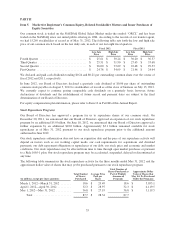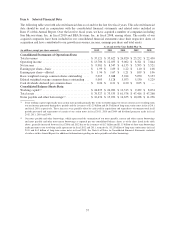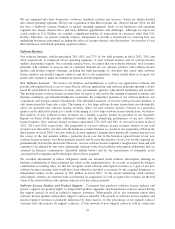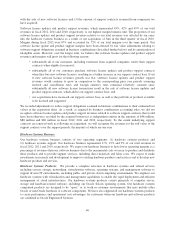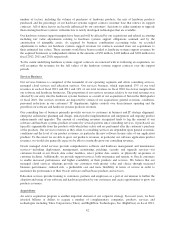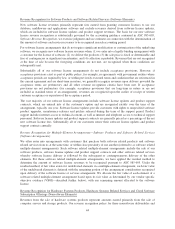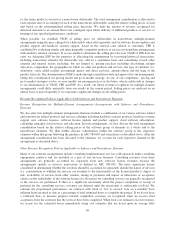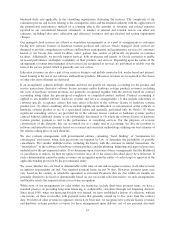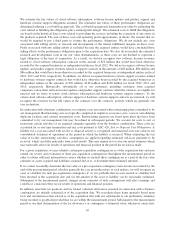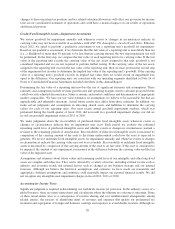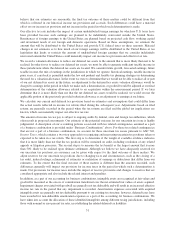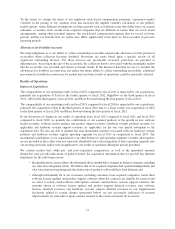Oracle 2012 Annual Report Download - page 49
Download and view the complete annual report
Please find page 49 of the 2012 Oracle annual report below. You can navigate through the pages in the report by either clicking on the pages listed below, or by using the keyword search tool below to find specific information within the annual report.other nonsoftware deliverables including hardware systems related services and cloud software subscription
offerings is based upon the accounting guidance contained in ASC 605, Revenue Recognition, and we exercise
judgment and use estimates in connection with the determination of the amount of hardware systems products,
hardware systems related services revenues and cloud software subscription revenues to be recognized in each
accounting period.
Revenues from the sales of our nonsoftware elements are recognized when: (1) persuasive evidence of an
arrangement exists; (2) we deliver the products and passage of the title to the buyer occurs; (3) the sale price is
fixed or determinable; and (4) collection is reasonably assured. Revenues that are not recognized at the time of
sale because the foregoing conditions are not met are recognized when those conditions are subsequently met.
When applicable, we reduce revenues for estimated returns or certain other incentive programs where we have
the ability to sufficiently estimate the effects of these items. Where an arrangement is subject to acceptance
criteria and the acceptance provisions are not perfunctory (for example, acceptance provisions that are long-term
in nature or are not included as standard terms of an arrangement), revenues are recognized upon the earlier of
receipt of written customer acceptance or expiration of the acceptance period.
Our hardware systems support offerings generally provide customers with software updates for the software
components that are essential to the functionality of our server and storage products and can also include product
repairs, maintenance services and technical support services. Hardware systems support contracts are generally
priced as a percentage of the net hardware systems products fees. Hardware systems support contracts are entered
into at the customer’s option and are recognized ratably over the contractual term of the arrangements, which are
typically one year.
Our cloud software subscription offerings generally provide customers access to certain of our software within a
cloud-based IT environment that we manage and offer to customers on a subscription basis. Revenues for our
cloud software subscription offerings are recognized ratably over the contract term commencing with the date
our service is made available to customers and all other revenue recognition criteria have been satisfied.
Revenue Recognition for Multiple-Element Arrangements—Hardware Systems Products and Hardware Systems
Related Services (Nonsoftware Arrangements)
We enter into arrangements with customers that purchase both nonsoftware related products and services from us
at the same time, or within close proximity of one another (referred to as nonsoftware multiple-element
arrangements). Each element within a nonsoftware multiple-element arrangement is accounted for as a separate
unit of accounting provided the following criteria are met: the delivered products or services have value to the
customer on a standalone basis; and for an arrangement that includes a general right of return relative to the
delivered products or services, delivery or performance of the undelivered product or service is considered
probable and is substantially controlled by us. We consider a deliverable to have standalone value if the product
or service is sold separately by us or another vendor or could be resold by the customer. Further, our revenue
arrangements generally do not include a general right of return relative to the delivered products. Where the
aforementioned criteria for a separate unit of accounting are not met, the deliverable is combined with the
undelivered element(s) and treated as a single unit of accounting for the purposes of allocation of the
arrangement consideration and revenue recognition. For those units of accounting that include more than one
deliverable but are treated as a single unit of accounting, we generally recognize revenues over the delivery
period. For the purposes of revenue classification of the elements that are accounted for as a single unit of
accounting, we allocate revenue to the respective revenue line items within our consolidated statements of
operations based on a rational and consistent methodology utilizing our best estimate of relative selling prices of
such elements.
For our nonsoftware multiple-element arrangements, we allocate revenue to each element based on a selling price
hierarchy at the arrangement’s inception. The selling price for each element is based upon the following selling
price hierarchy: VSOE if available, third party evidence (TPE) if VSOE is not available, or estimated selling
price (ESP) if neither VSOE nor TPE are available (a description as to how we determine VSOE, TPE and ESP is
provided below). If a tangible hardware systems product includes software, we determine whether the tangible
hardware systems product and the software work together to deliver the product’s essential functionality and, if
45


